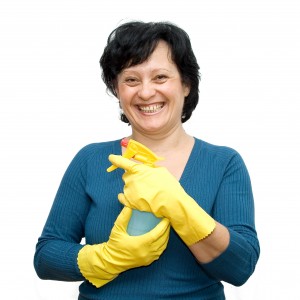 When it comes to green cleaning, less is definitely more! As we grew up our training and childhood belief systems focused more on the concept that “more is better.” The old adage that an ounce of prevention is worth a pound of cure” is certainly true with green cleaning products and green janitorial chemicals.
When it comes to green cleaning, less is definitely more! As we grew up our training and childhood belief systems focused more on the concept that “more is better.” The old adage that an ounce of prevention is worth a pound of cure” is certainly true with green cleaning products and green janitorial chemicals.
Traditional cleaning involves practices such as the use of feather dusters, loads of paper towels, and a large suite of cleaning chemicals. There seems to be something for everything. Unfortunately this leads to significant consumption and wasteful practices. Additionally we were taught if the cleaning products were colored and it smelled something like Pine Sol it was clean and thus good. Unfortunately most of the conventional cleaning chemicals we know (and sometimes love) from our upbringing are petroleum-based and have dubious health and environmental implications.
Perhaps the most compelling reason to use natural green home cleaning products and green janitorial supplies rather than the traditional cleaning chemicals is to keep potent toxins out of our lives and away from those we care for and love. Many traditional cleaners are petroleum based and contain volatile organic compounds (VOCs), such as formaldehyde, and harsh acids. Since US EPA has identified that indoor VOC levels are often two to five times greater than outdoor levels, humans can experience eye, nose, and throat irritation; headaches; loss of coordination; nausea; and damage to liver, kidney, and central nervous systems from exposure to these chemicals. The agency further states some VOCs can cause cancer in animals and some are suspected or known to cause cancer in humans.
There are new cleaning technologies you can leverage to clean green such as using microfiber cloths, changing your strategy from “spray and wipe” to one of “spray and rotate” with the new enzyme cleaners, and transitioning from a “dust first” approach to one of “prevent and eliminate”. Each of these many small changes in your green cleaning practice for residential and commercial applications is extremely effective and has a large accumulative result.
As a cleaning agent, water generally is not a sufficient cleaner. Homemade solutions are often found to be both cumbersome and/or ineffective. Additionally traditional cleaning products (even the green ones) have a bevy of harmful implications to human health that we do not realize. For example take those so-called air fresheners. We believe they are effective; however, they are actually neurotoxins that deaden our sense of smell rather than working to eliminate the odors. According to a study published in New Scientist in 1999, in homes where aerosol sprays and air fresheners were used frequently, mothers experienced 25% more headaches and were 19% more likely to suffer from depression, and infants under six months of age had 30% more ear infections and 22% higher incidence of diarrhea.
For this reason in addition to changing your cleaning strategies and increasing the use of green cleaning products for natural green home cleaning is important. It is strategic, and vital, for your business to have an Environmentally Preferable Purchasing program that includes the purchase of healthier, safer, green janitorial supplies and chemicals.
Understanding the cleaning chemicals you are using is paramount. In selecting your natural green home cleaning products or your green janitorial chemicals, it is important, as the consumer, to be alert to greenwashing. Just because a product says it is natural or that it is green does not mean it is nontoxic. It is best to choose products that are rated green by independent third party organizations, such as the US EPA Design for the Environment (DfE) Program. Some guidelines to use are:
- Choose products that are pH neutral. Review the Material Safety Data Sheets (MSDS) to ensure no short term (acute) or long term (chronic) health hazards are identified.
- Look at labels for specific, eco friendly ingredients that also perform effectively. For example, select dish and laundry detergents and all-purpose cleaners that are plant-based (corn, palm kernel, or coconut oil) rather than petroleum based chemicals.
- Remember hot, soapy water is extremely effective in killing food-borne pathogens such as salmonella or E coli.
- Use pump action dispensers rather than aerosol cans with pressurized propellants
- Avoid cleaning products that annihilate everything in their path. They are not green. Additionally many disinfectants are poor cleaners due to the fact that they are designed to kill living organisms as opposed to being designed to remove soils, dust and dirt. Recognize that a green cleaning products designed to wash away and destroy the organic matter on surfaces will not allow germs to grow and feed.
- Seek opportunities to reduce packaging as this creates less waste and reduces the associated transportation impacts. One way to do this is to stay away from products that have you purchase a large bottle to pour into a smaller container, i.e., a gallon jug that will be used to refill a quart spray bottle for use especially if it is a ready to use product where the primary ingredient is water.
Some specific actions you, your housekeepers, and your janitors can take during the green cleaning process are presented in the next blog post. Read more about how to clean green …
[…] first post in this series presented to you some changes you can take in your cleaning strategy. Some cost […]